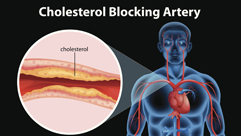Treatment of cholesterol problems
All patients with high LDL-C - concentrations of low-density lipoprotein in their blood - should undertake lifestyle changes with the goal of reducing serum cholesterol. This is universally agreed on within the medical community. How? Possible changes include:
- fat loss in overweight patients
- decreasing saturated and overall fat in the diet (this method is debated by some people)
- exercise
- increased consumption of plants with the goal of eating more sterols and stanols (these are chemicals in vegetables)
Most of the cholesterol in our bodies was made in our bodies; it is not from diet. The problem of dyslipidemia has attracted the attention of many scientists. A study conducted by the United Kingdom Lipid Clinics concluded that with diet alone, a mean body weight reduction of 1.8 percent was attained by 60% of people, leading to a 5 to 7 percent reduction of LCL-C. Some experts think LDL-C can be reduced by up to thirty percent with other diets.
An additional study of people diagnosed with low levels of HDL-C and moderately raised levels of LDL-C arbitrarily assigned individuals into four groups of non-treatment, aerobic exercise, exercise and diet, or simply diet. The study results indicated no group attained a significant HDL-C change, however the LDL-C reductions were significant for both women and men for groups with combined exercise and diet or simply with diet, and for the group of men with diet and exercise as compared to solely exercise. These results reflect a common theme in the world of cholesterol treatment; it is a lot easier to reduce LDL-C levels than it is to raise HDL-C levels.
 Once patients start a statin regimen, within 6 to 12 months, the benefits of LDL-C reduction may become evident. Various factors impact an individual’s response to a cholesterol-lowering diet; genetics may impact this response, and a reduced response to dietary change as evidenced by an expanded body mass index.
Once patients start a statin regimen, within 6 to 12 months, the benefits of LDL-C reduction may become evident. Various factors impact an individual’s response to a cholesterol-lowering diet; genetics may impact this response, and a reduced response to dietary change as evidenced by an expanded body mass index.
Drug therapy
Patients unable to attain the required cholesterol levels with diet and exercise changes usually go on drug therapy.
Lipid-altering agents include several drug classes: bile acid sequestrants, statins, nicotinic acid, cholesterol absorption inhibitors and fibric acid derivatives. These drugs work by different pathways inside the body.
Study after study has found improvements in overall mortality from a regimen of statins for primary and secondary prevention of coronary heart disease and ischemic stroke. The effect on secondary prevention (reducing risk in patients who have had incidents) is considerable. The effect on primary prevention (asymptomatic patients) is lower and there is an on-going debate about whether the benefits of statins outweigh the side effect risks for these patients.
Over the decades and through many clinical trials and observations of thousands of patients, statins have carved out a niche in the healthcare ecosystem. Statins are the preferred choice for hypercholesterolemia patients now. When statins cannot help patients to meet LDL-C goals, doctors often try the addition of ezetimibe or other prescriptions. Even if these help lower cholesterol levels, they the science backing up claims of further clinical benefits. Other drugs try, but none are as good as statins.
Lifestyle Changes
Improvements in diet along with statin use can really help the lipid profile. One randomized study analyzed the effects of a typical diet versus a Mediterranean modified diet of dietary fiber, fruits, and vegetables rich in omega-3 fatty acids; an additional level of randomization was introduced of a placebo or simvastatin (20 mg) which was introduced after a period of twelve weeks. After a 24 week period, the improvement in triglyceride levels and other biomarkers was greater in those with the modified diet and drug regimen than those of the typical diet and drug. A diagnostic biomarker is one with high specificity and sensitivity, one that can show the severity of disease and which allows for the monitoring of therapeutic effects.
Despite concerns about side effects, statins produce less frequent adverse reactions compared with other types of lipid-lowering agents. For patients treated with a fibrate or cyclosporine, muscle injury is a significant concern. Myopathy can happen with statins, too, but the risk-benefit profile is generally considered better.
Exercise is recommended a way to reduce the risk of cardiovascular problems. A study published in Lancet found that exercise and a statin regimen together have a synergistic effect. That is, the benefits of the combination exceed the benefits of either one alone for treatment of dyslipidemia. This suggests they work in different beneficial ways inside the body.
The Institute of Medicine (IOM) developed a framework for evaluating health care with six aims: (1) safe, (2) effective, (3) patient-centered, (4) timely, (5) efficient, and (6) equitable.


